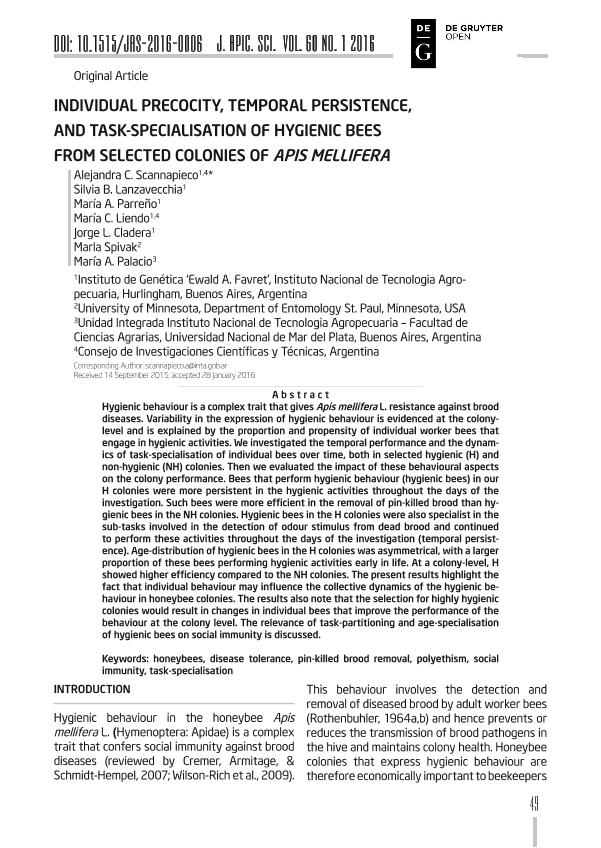Mostrar el registro sencillo del ítem
dc.contributor.author
Scannapieco, Alejandra Carla

dc.contributor.author
Lanzavecchia, Silvia Beatriz

dc.contributor.author
Parreño, Maria Alejandra

dc.contributor.author
Liendo, María Clara

dc.contributor.author
Cladera, Jorge Luis

dc.contributor.author
Spivak, Marla
dc.contributor.author
Palacio, Maria Alejandra

dc.date.available
2020-09-14T15:07:56Z
dc.date.issued
2016-06
dc.identifier.citation
Scannapieco, Alejandra Carla; Lanzavecchia, Silvia Beatriz; Parreño, Maria Alejandra; Liendo, María Clara; Cladera, Jorge Luis; et al.; Individual precocity, temporal persistence and taskspecialization of hygienic bees from selected colonies of Apis Mellifera; Research Inst Pomology Floriculture; Journal of Apicultural Science; 60; 1; 6-2016; 49-60
dc.identifier.issn
1643-4439
dc.identifier.uri
http://hdl.handle.net/11336/113914
dc.description.abstract
Hygienic behaviour is a complex trait that gives Apis mellifera L. resistance against brood diseases. Variability in the expression of hygienic behaviour is evidenced at the colonylevel and is explained by the proportion and propensity of individual worker bees that engage in hygienic activities. We investigated the temporal performance and the dynamics of task-specialisation of individual bees over time, both in selected hygienic (H) and non-hygienic (NH) colonies. Then we evaluated the impact of these behavioural aspects on the colony performance. Bees that perform hygienic behaviour (hygienic bees) in our H colonies were more persistent in the hygienic activities throughout the days of the investigation. Such bees were more efficient in the removal of pin-killed brood than hygienic bees in the NH colonies. Hygienic bees in the H colonies were also specialist in the sub-tasks involved in the detection of odour stimulus from dead brood and continued to perform these activities throughout the days of the investigation (temporal persistence). Age-distribution of hygienic bees in the H colonies was asymmetrical, with a larger proportion of these bees performing hygienic activities early in life. At a colony-level, H showed higher efficiency compared to the NH colonies. The present results highlight the fact that individual behaviour may influence the collective dynamics of the hygienic behaviour in honeybee colonies. The results also note that the selection for highly hygienic colonies would result in changes in individual bees that improve the performance of the behaviour at the colony level. The relevance of task-partitioning and age-specialisation of hygienic bees on social immunity is discussed.
dc.format
application/pdf
dc.language.iso
eng
dc.publisher
Research Inst Pomology Floriculture

dc.rights
info:eu-repo/semantics/openAccess
dc.rights.uri
https://creativecommons.org/licenses/by-nc-nd/2.5/ar/
dc.subject
DISEASE TOLERANCE
dc.subject
HONEYBEES
dc.subject
PIN-KILLED BROOD REMOVAL
dc.subject
POLYETHISM
dc.subject
SOCIAL IMMUNITY
dc.subject
TASK-SPECIALISATION
dc.subject.classification
Zoología, Ornitología, Entomología, Etología

dc.subject.classification
Ciencias Biológicas

dc.subject.classification
CIENCIAS NATURALES Y EXACTAS

dc.title
Individual precocity, temporal persistence and taskspecialization of hygienic bees from selected colonies of Apis Mellifera
dc.type
info:eu-repo/semantics/article
dc.type
info:ar-repo/semantics/artículo
dc.type
info:eu-repo/semantics/publishedVersion
dc.date.updated
2020-09-11T18:50:19Z
dc.journal.volume
60
dc.journal.number
1
dc.journal.pagination
49-60
dc.journal.pais
Polonia

dc.journal.ciudad
Pomologiczna
dc.description.fil
Fil: Scannapieco, Alejandra Carla. Instituto Nacional de Tecnología Agropecuaria. Centro de Investigación en Ciencias Veterinarias y Agronómicas. Instituto de Genética; Argentina. Consejo Nacional de Investigaciones Científicas y Técnicas; Argentina
dc.description.fil
Fil: Lanzavecchia, Silvia Beatriz. Instituto Nacional de Tecnología Agropecuaria. Centro de Investigación en Ciencias Veterinarias y Agronómicas. Instituto de Genética; Argentina. Consejo Nacional de Investigaciones Científicas y Técnicas; Argentina
dc.description.fil
Fil: Parreño, Maria Alejandra. Instituto Nacional de Tecnología Agropecuaria. Centro de Investigación en Ciencias Veterinarias y Agronómicas. Instituto de Genética; Argentina. Consejo Nacional de Investigaciones Científicas y Técnicas; Argentina
dc.description.fil
Fil: Liendo, María Clara. Instituto Nacional de Tecnología Agropecuaria. Centro de Investigación en Ciencias Veterinarias y Agronómicas. Instituto de Genética; Argentina. Consejo Nacional de Investigaciones Científicas y Técnicas; Argentina
dc.description.fil
Fil: Cladera, Jorge Luis. Instituto Nacional de Tecnología Agropecuaria. Centro de Investigación en Ciencias Veterinarias y Agronómicas. Instituto de Genética; Argentina
dc.description.fil
Fil: Spivak, Marla. University of Minnesota; Estados Unidos
dc.description.fil
Fil: Palacio, Maria Alejandra. Universidad Nacional de Mar del Plata. Facultad de Ciencias Agrarias. Departamento de Producción Animal. Cátedra de Apicultura; Argentina. Instituto Nacional de Tecnología Agropecuaria; Argentina
dc.journal.title
Journal of Apicultural Science

dc.relation.alternativeid
info:eu-repo/semantics/altIdentifier/doi/http://dx.doi.org/10.1515/JAS-2016-0006
dc.relation.alternativeid
info:eu-repo/semantics/altIdentifier/url/https://content.sciendo.com/configurable/contentpage/journals$002fjas$002f60$002f1$002farticle-p63.xml
Archivos asociados
